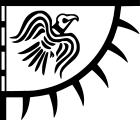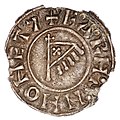
Back Estandarte'l Cuervu AST Сцяг крумкача Byelorussian Estendard del corb Catalan Ravnebanner Danish Rabenbanner German Estandarte del cuervo Spanish Belearen zutoihala Basque Bannière au corbeau French Estandarte do corvo Galician דגל העורב HE
The raven banner (Old Norse: hrafnsmerki [ˈhrɑvnsˌmerke]; Middle English: hravenlandeye) was a flag, possibly totemic in nature, flown by various Viking chieftains and other Scandinavian rulers during the 9th, 10th and 11th centuries.[citation needed] Period description simply describes it as a war banner with a raven mark on it,[citation needed] although no complete visual description or depiction of the raven banner is known from the time. Norse and European period artwork, however, depicts war banners[citation needed] as roughly triangular, with a rounded outside edge on which there hung a series of tabs or tassels, some with a resemblance to ornately carved "weather-vanes" used aboard Viking longships, indicating that some raven banners may have been constructed in a similar manner.
Scholars[who?] conjecture that the raven flag was a symbol of Odin, who was often depicted accompanied by two ravens named Huginn and Muninn. Its intent may have been to strike fear in one's enemies by invoking the power of Odin. As one scholar notes regarding encounters between the Christian Anglo-Saxons and the invading pagan Scandinavians:
The Anglo-Saxons probably thought that the banners were imbued with the evil powers of pagan idols, since the Anglo-Saxons were aware of the significance of Óðinn and his ravens in Norse mythology.[1]
- ^ Hrafnhildur Bodvarsdottir (1976) p. 112.




